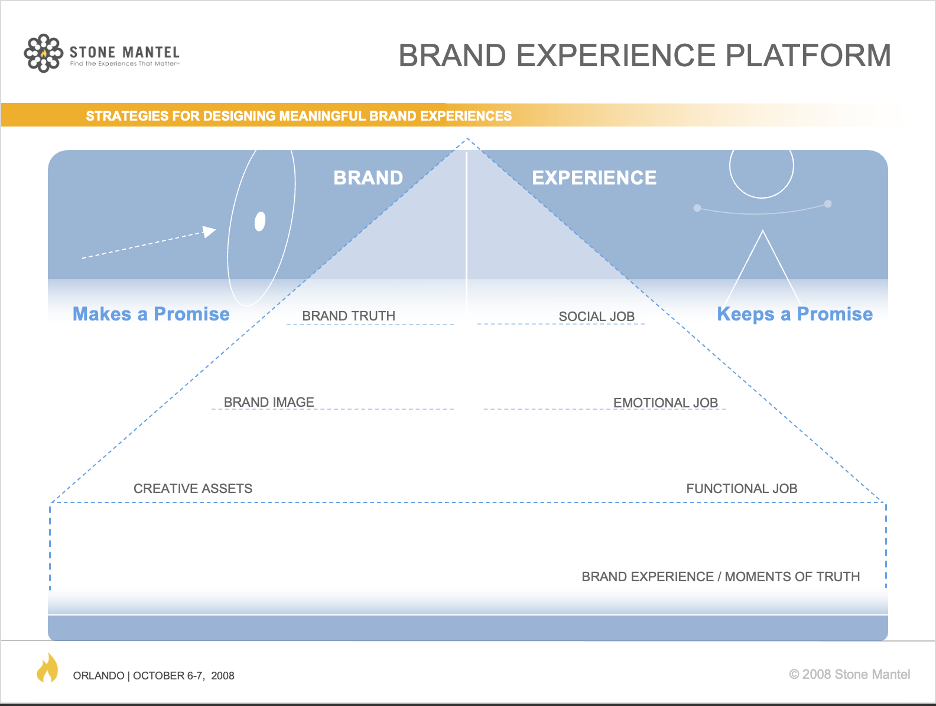An Introduction to Chapter 3
Chapter Three: Principle 2—To Be Compelling Requires a Strategic Point of View
Dear Friends,
This is the first installment of chapter three. The focus is on how to make your business model compelling. It’s not focused on how to make your solution compelling. And, as you will see, it departs dramatically from brand experience orthodoxy.
I am very familiar with brand experience orthodoxy. I helped to popularize the axiom: a brand makes a promise; an experience keeps a promise.
This axiom has limited both experience strategy and brand strategy. I will explain.
I have heard now from a number of you. Each of you have said, keep the emails coming. Today, a friend told me that they push him to think. I’m so glad.
In order for me to get this treatise published, I need a whole lot more readers. A favor: please share these posts widely!
Chapter Three: Principle 2—To Be Compelling Requires a Strategic Point of View
What’s more important than branding? Having a point of view.
Chapter Objective
Most companies build their go-to-market strategies around differentiation, or being unique and compelling. This has been the hallmark for attracting new customers and keeping current customers for 75 years. Differentiation, they believe, is what compels customers to be loyal.
Maybe that worked in the past, but not now.
Experience strategy has its roots in a different kind of soil. What makes a business model compelling to a large population of individuals isn’t current uniqueness, but rather an anticipation of future needs. The customer wants new and compelling experiences that evolve and get better over time. It is the company’s responsibility to anticipate what the customer will want in the future and chart a course that marshals company resources toward that end. To do this, the company needs insights into the customer that will help them see what the opportunity is—and build solutions for their future needs.
My objective in this chapter is not to diminish the important work of brand strategy, or marketing in general. It’s to demonstrate that there is something that sits under differentiation, something that grounds a company’s brand when the world is inundated with content and there is an abundance of solutions that people can choose from. Having a point of view about the near future needs of people is what makes a business model compelling.
Chapter Summary
· Differentiation is not enough today
· The experience is not the delivery of a brand promise
· What is a strategic point of view
· How a point of view shapes a business model
· Finding insights about near future needs
· Articulating the point view for internal audiences
· Aligning business silos with a point of view
Introduction:
In a world of abundance, a company cannot afford to rely on differentiation.
I believe in storytelling. I started my career, like so many experience strategists, in brand strategy. I know how important it is to stand for something. I am always in awe of a campaign that captures the imagination of a culture. ‘Just Do it.’ ‘Got milk?’ These were brand campaigns I admired in my 20s. Today, I’m still blown away by Geico’s brand strategy. They break all of the rules of brand strategy while at the same time changing a category through personality.
Talk about breaking rules. Progressive runs it’s Flo campaign while introducing its ‘becoming your parents’ campaign. Who does that? Both work extremely well, for their intended audiences.
Brand personality, an invention of the 80s, is having a renaissance today. With so much undifferentiated product out there, having a brand personality—or in the case of both Geico and Progressive—brand personalities are a powerful way to differentiate.
Insurance is boring. But the talented agencies who build these campaigns make us pay attention, identify with, and engage with the brand.
Brand strategy is about more than advertising. The best brands embody the culture and ethos of the company. They stand for something. They evoke emotion and make people proud to spend time with company. They give employees purpose. Storytelling is only part of brand strategy, but it’s the most visible part.
A great story, told repeatedly, will, over time, create loyalty to the brand, which will, in turn, lead to repeat business, and hopefully, growth.
There are multiple problems with the way brand strategy is understood today. This book won’t examine all of them. My goal is to articulate experience strategy, not fix brand strategy. Still, a few things bear mentioning.
1. Brand strategies take time to develop loyalty but they are easily replicated.
2. People love the stories but don’t necessarily convert to customers.
3. There is so much content and no appetite for intrusive commercials.
4. There is so much solution sameness. The brand becomes a veneer.
I could go on. But the real issue is not brand strategy. The real issue is how companies think about what compels people to engage. Engagement, from the traditional business model perspective, is any interaction that encourages product consideration, purchase, or usage. Engagement, from the customer’s perspective, is a fixed, biological box. There is only so much engagement that human body can take.
Sometimes people can engage more intensely. Other times they can’t. Too much engagement causes stress. Too little engagement is boring. The customer needs to engage in order to get certain things done, like work. But there’s a different type of engagement going on when they are in front of the TV at the end of the day. Most companies aren’t interested in the fixed, biological box. They want all of the customer’s attention as often as they can get it.
In a world of abundance, that level of messaging creates tremendous pressure on people’s bodies and minds. So, the human adapts. We block ads with our brains. We zone out. We avoid as many messages as possible and try to find ways to escape brand building activities.
So what do brand strategists do? They try to be funnier, louder, and more omni-present. They turn social issues into platforms for messaging. They turn anything they can get their hands on into a story to promote the brand. All of which affects the fixed, biological box—in a bad way.
How Not to Compel a Large Group of Individuals
In chapter two, I described a fundamental difference between marketing and experience strategy. Marketers see people as segments. Experience strategists see people as individuals. There are some good reasons for marketers to do segmentation work on their target audience. But those reasons are limited to messaging and not the purpose of this chapter.
When companies customize experiences for their customers, they are treating them as individuals. People like to be treated as individuals and especially like it when companies understand their situational needs. In fact, the most effective way to engage a customer is to customize the experience to their situation. It works flawlessly.
Customizing an experience to a situation has almost nothing to do with advertising and storytelling in general. How, then, do you not compel a large group of customers who want to be treated as individuals? Cram the experience full of generalized storytelling.
The Broken Brand Experience Framework
The origins of the idea that brand strategy and experience strategy are one and the same are based in one statement made back in 1998. In a letter to the Harvard Business Review editor about Pine & Gilmore’s article, Welcome to the Experience Economy, a reader made the following statement:
A brand is the promise of an experience
I seized on that idea and began telling our clients at the time that the two disciplines were actually connected. I said,
Brand strategy is about promise making;
Experience strategy is about promise keeping
And here’s the framework that I created to show the relationship between branding and experience design.
In this version of our brand experience framework you can see a simplified brand strategy on the left and a simplified experience strategy on the right. The brand stands for something (the brand truth). There is an image the company is trying to portray. And there are creative assets. Those are the promise making tools.
On the right is the experience platform which is clearly focused on the functional, emotional, and social jobs to be done. That’s the strategic framework for creating value and driving innovation in the organization. Then, below the pyramid are the moments of truth. These are the moments that must deliver on both the brand and the job to be done in order to deliver the brand experience.
Pretty snazzy!
For about 10 years, we at Stone Mantel used this framework, or versions of it, to help our clients to think about very important things like their brand’s greater purpose, storytelling, how to innovate, and how to create experiences. The framework brought together three disciplines: brand, innovation, and experience.
I think it was the perfect framework for the time. 2000 to 2010. It helped three competing disciplines work together and focus on aligning strategies.
But on June 29, 2007, Steve Jobs introduced the iPhone. Within three years, a radically different world emerged. More important than the Great Recession, the smart phone remapped business models. Combined with ecommerce and the internet, the iPhone changed customer expectations. Functionality trumped form. Streaming changed storytelling.
The discipline most affected by digital was branding. Innovation took over. Experience shifted from the ‘themed’ to the omnichannel experience. Everyone knew what the near future needs of people would be. An app store in every kitchen; a navigation app in every car.
As eyeballs moved away from cable TV, brand strategists were in a quandary. They realized that their framework for engagement was based on linear TV media and place-based experiences. Sure, a website could be branded. But it was uncertain what role branding played in apps, in Amazon.com, in streaming services, and video games.
More concerning was the proliferation of solutioning. The barriers to business entry in a market dropped to almost nothing, at least temporarily. Banks had to compete with fintech. Retailers with, well, Amazon.
To be continued …
Click here for book outline with links to posts
This post about Experience Strategy Certification is also helpful.






